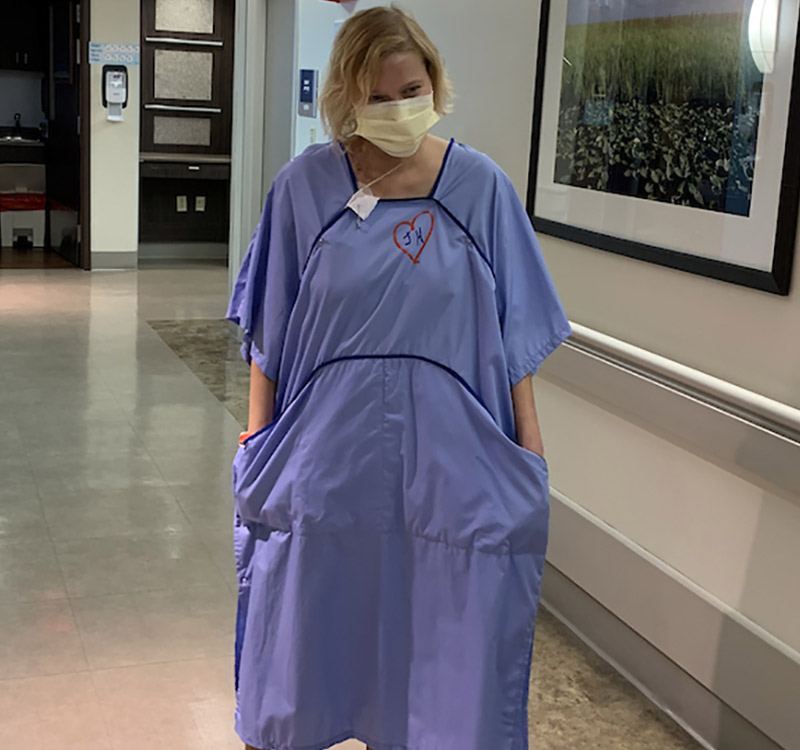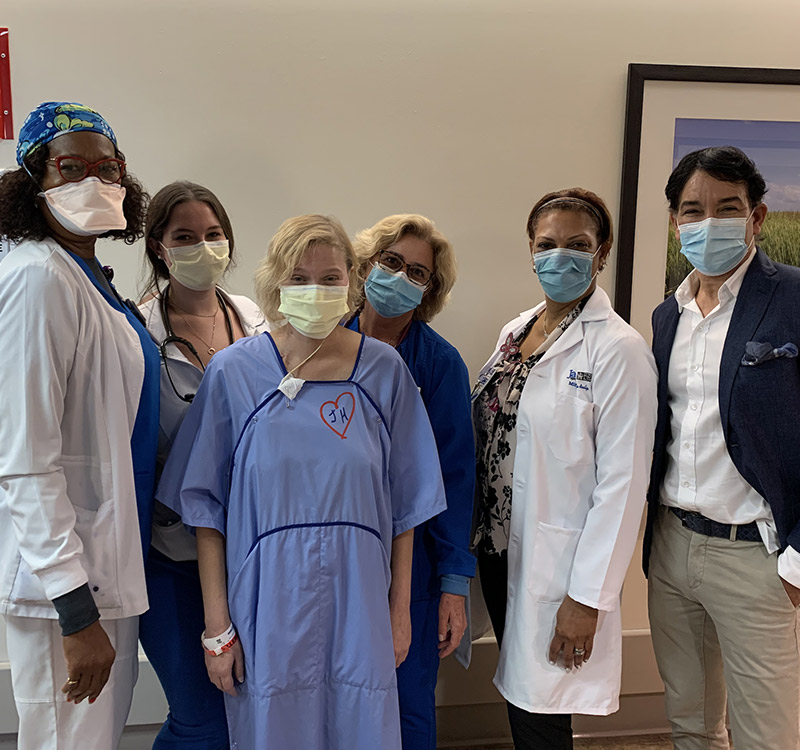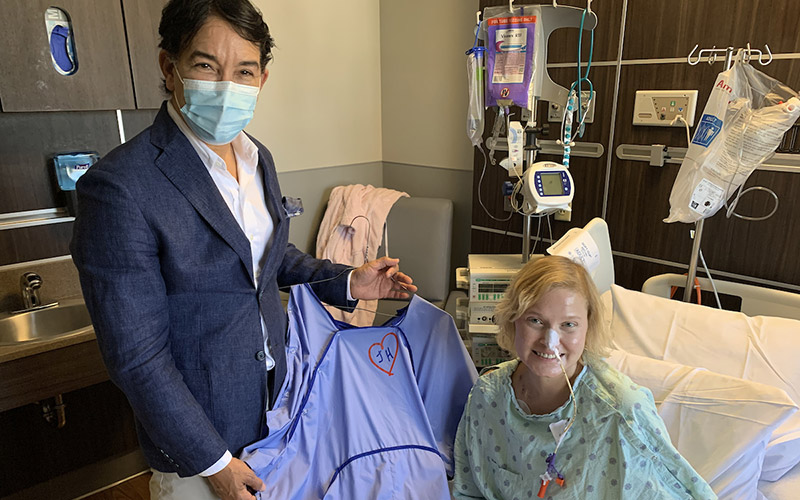The Perfect Match: South Florida Teacher’s Life Saved by Living Donor
The Perfect Match: South Florida Teacher’s Life Saved by Living Donor
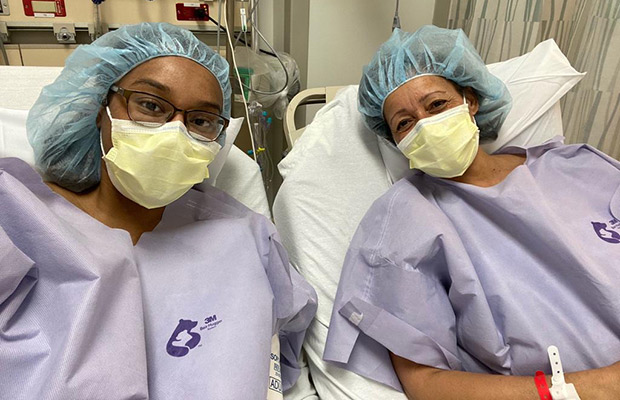
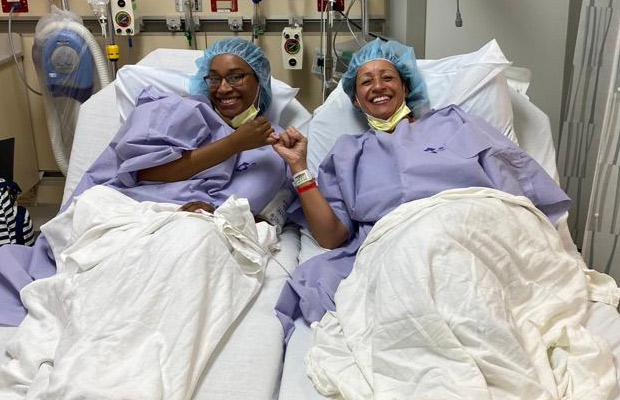
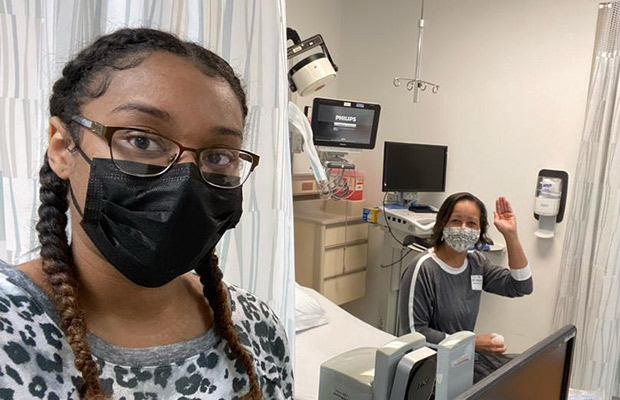
In November 2020, Tyra Starnes was shocked when her primary care doctor diagnosed her with chronic kidney disease during a routine annual exam. Up until that point, the 25-year-old West Palm Beach elementary school teacher felt healthy.
However, as her kidneys continued to deteriorate, Starnes started feeling the effects of the disease. She often felt fatigued and had developed a metallic taste in her mouth.
In April 2021, her primary care doctor referred her to Giselle Guerra, MD, medical director of transplant services and medical director of the kidney program at the Miami Transplant Institute (MTI), an affiliation between Jackson Health System and UHealth – University of Miami Health System.
Dr. Guerra took over Starnes’ treatment, immediately putting her on peritoneal dialysis, a system to remove waste from her kidneys. Shortly thereafter, Starnes and the MTI team started discussing the possibility of a kidney transplant as the best course of treatment.
“Those at risk of high blood pressure, diabetes, or who have a family history of kidney disease can develop chronic kidney disease,” Dr. Guerra explained. “Tyra had none of those things. Her disease was a result of an acute immune response that rapidly deteriorated her kidney function.”
After starting peritoneal dialysis, Starnes was placed on the national transplant list. As her condition worsened, her family came together in her support. Many of her loved ones quickly signed up to be tested as potential donors.
As fate would have it, Starnes’ great-aunt and godmother, Lesley Anderson, was a perfect match.
“When asked time and time again if I was certain I wanted to be a donor, I never questioned my answer,” Anderson said. “Tyra is my goddaughter. I was meant to be her donor. I wouldn’t have had it any other way.”
After nine months of peritoneal dialysis and follow-up appointments with the MTI team, the date for the surgery was set for January 26, 2022.
“I remember feeling drained after my last dialysis session,” Starnes recalled. “I wanted to have control over my life again. I didn’t want to wait any longer.”
On the day of the surgery, Starnes felt both worried and relieved, although she knew she was in the best hands.
A multidisciplinary team led by Rodrigo Vianna, MD, PhD, MTI’s director of transplant services and chief of liver and gastrointestinal transplant programs performed the living kidney donor transplant on Anderson using the da Vinci Surgical System. Gaetano Ciancio, MD, MTI’s chief academic and medical officer and director of the kidney and kidney-pancreas programs, transplanted Starnes.
“Robotic surgery minimizes surgical complications for living kidney donor patients. It often lessens medical risks due to shortened hospitals stays. More than 95 percent of our donors who have undergone this robotic procedure stayed in the hospital for less than 24 hours,” Dr. Vianna said. “The surgical expertise of our MTI physicians with the most complex cases, particularly when paired with innovative devices, such as the da Vinci robot, will help catapult health care to the next level for our transplant patients.”
Starnes and Anderson’s surgeries were a success, and they were both discharged on the same day. The two plan to celebrate on January 26 every year to commemorate their transplant anniversary.
“I want to let everyone know they don’t have to be afraid of becoming organ donors and should consider it,” Starnes said. “It can one day help save someone’s life.”
Patients with End-Stage Heart Failure Survive and Thrive with the LVAD Option
Patients with End-Stage Heart Failure Survive and Thrive with the LVAD Option
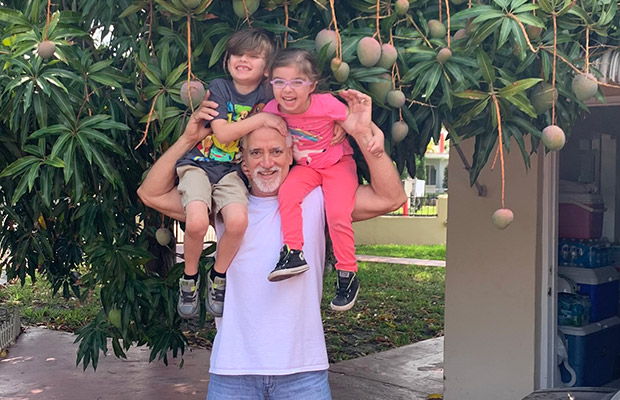
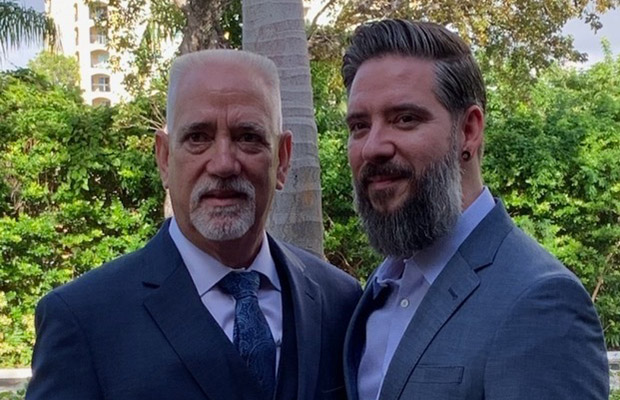
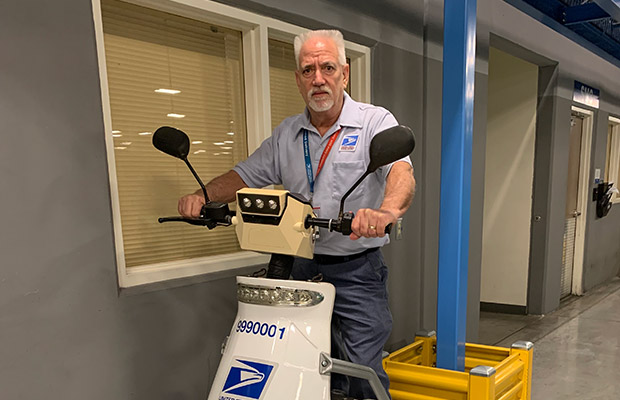
For a few months, Juan Llanes felt some discomfort in his stomach. To ease the pain, he’d drink water and feel better.
The 63-year-old postal worker never suspected his stomach issues were a sign of heart failure. Then, on January 16, 2021, he suffered a massive heart attack at home.
“Until it happened, I felt like Superman,” Llanes said.
Llanes, who never had a history of cardiac issues before his heart attack, credits his wife, Rosie Llanes, for acting quickly and dialing 911 after noticing her husband in discomfort as he was standing up from their couch.
He was rushed to a nearby hospital, where doctors inserted a stent in his coronary artery to help restore his heart’s blood flow. Unfortunately, there were serious complications.
Llanes went into multiple-organ failure and cardiogenic shock – a life-threatening condition in which the heart suddenly can’t pump enough blood to support the body’s needs. He was referred to the Miami Transplant Institute (MTI) at Jackson Memorial Hospital.
Llanes was placed into a medically induced coma for two weeks and on dialysis for two months. He was weak, and his medical team at MTI, led by Anita Phancao, MD, Chief of Heart Failure, Mechanical Circulatory Support, Transplant Cardiology at MTI, had to stabilize him if he was going to survive.
Dr. Phancao and her staff determined that Llanes’ best chance to survive was to implant in his chest a left ventricular assist device (LVAD), a battery-operated, mechanical pump that helps the lower left heart chamber pump blood to the rest of the body. The LVAD minimizes risk and offers patients enhanced quality of life.
Dr. Phancao consulted with Matthias Loebe, FACC, MD, PhD, FCCP, a leading heart transplant surgeon and Chief of Heart and Lung Transplant and Medical Support at MTI, and Llanes’ surgery was scheduled for March 10, 2021.
“This operation was the optimal option for Juan,” Dr. Loebe said. “We surgically implant the LVAD in patients who have reached end-stage heart failure and are not organ transplant candidates.”
Dr. Loebe said LVADs are a great option that help save many lives.
“The survival rate with the newest generation of LVADs is getting close to actual heart transplants,” Dr. Loebe said. “You can have an LVAD and live 10 to 12 more years.”
Llanes’ LVAD was implanted through open-heart surgery. The procedure lasted about five hours, but the length varies from patient to patient depending on their cardiac health and history.
In the hospital, a multi-disciplinary team that included nutritionists and psychologists worked with Llanes and prepared him to go home and adjust to his new lifestyle.
“What sets us apart is that we can provide the full spectrum of support,” Dr. Phancao said. “We have all the tools available to us. We prioritize educating our patients so they have a positive transition to living with an LVAD.”
Given a second chance to live, Llanes hopes to return to the workforce soon and is enjoying time with his family.
“Because of the great medical team I had at MTI, I can see my grandchildren grow up,” Llanes said. “I didn’t know about LVADs, but that procedure saved my life, and I hope this information can help save many more lives.
A Birthday Miracle: A New Heart Gives One Florida Man A Second Chance at Life
A Birthday Miracle: A New Heart Gives One Florida Man A Second Chance at Life
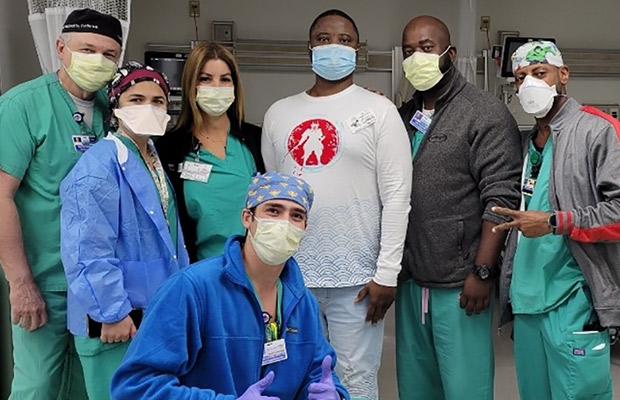
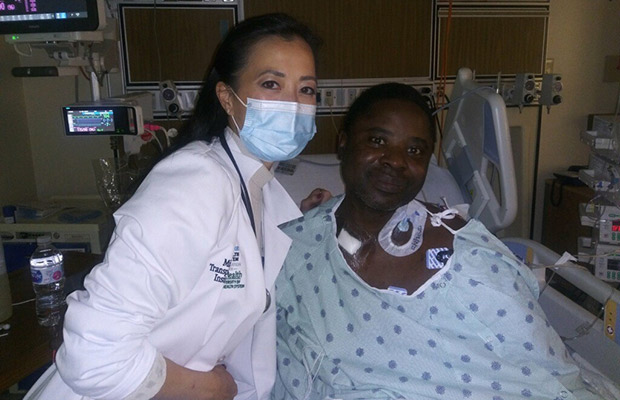
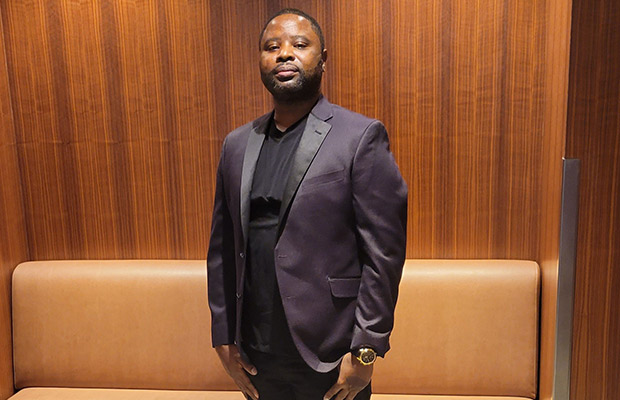
Harold Jean never knew that he was born with a heart condition. He lived a normal childhood, played sports, and exercised. But in 2005, at the age of 23, he suffered a minor stroke.
He quickly recovered, but it was the beginning of a series of health problems. Ten years later, at age 33, Jean learned his heart was weak. He was diagnosed with congestive heart failure and needed a pacemaker to help control his heartbeat.
“Even with the pacemaker, I could run and exercise,” he said. “I used to ride my bike often and was part of the Brickell Run Club.”
However, that all changed on November 23, 2020.
“I was home alone when all of a sudden, I couldn’t breathe,” he recalled.
He immediately called for a ride to Jackson Memorial Hospital.
“When I arrived at the hospital, I fainted in the emergency department,” he said. “After I woke up, I was in a hospital bed. The doctors told me if I hadn’t made it to the hospital when I did, I would’ve died.”
Anita Phancao, MD, FACC, Chief of Heart Failure, Mechanical Circulatory Support, Transplant Cardiology at the Miami Transplant Institute, was one of the doctors treating Jean.
“When Harold arrived at the hospital, he was experiencing shortness of breath, and we quickly discovered he was in cardiogenic shock, which means his heart could not pump enough blood through his body,” Dr. Phancao said. “We started him on IV medication to help support his heart and put in a balloon pump and admitted him to the intensive care unit (ICU). He was very sick, and so we put in for expedited advanced cardiac therapy, including listing him for a heart transplant.”
Due to the ongoing COVID-19 pandemic, visitors weren’t allowed in the hospital, so Jean couldn’t have his family at his bedside. Luckily, the ICU nurses caring for him stepped in. They spent time talking with him and keeping his spirits up.
“I love my nurses,” he said. “They took incredible care of me and became my family in their absence. They were so important for my mental health.”
On his birthday, the nurses that Jean had begun to call family surprised him with a cake and a birthday celebration. Then came the greatest gift of all.
“My nurse surprised me with the news that I would be receiving a new heart,” Jean said. “I was so overwhelmed with emotion and began to cry.”
On December 14, 2020 – Jean’s 40th birthday – Jean underwent a successful heart transplant.
“Despite everything going on in the world with the pandemic, our transplant team has remained steadfast and committed to performing these lifesaving procedures,” said Matthias Loebe, MD, PhD, FCCP, FACC, Chief of Heart and Lung Transplant and Mechanical Support at Miami Transplant Institute, who performed Jean’s heart transplant.
After his transplant, Jean remained hospitalized, undergoing physical therapy at the Christine E. Lynn Rehabilitation Center for The Miami Project to Cure Paralysis at UHealth/Jackson Memorial for six months as he slowly recovered and learned to walk again.
“It was a difficult challenge, but I trusted the process,” he said. “By practicing my rehab exercises each day, I was finally able to walk. Jackson is truly the best hospital in the world. They did a great job, and now I’m back to living my life.”
For Jean’s medical team, seeing him thrive is the best gift.
“Our number one goal when performing a transplant,” Dr. Loebe said, “is to help our patients get better and well enough to go back to living their life.”
Today, Jean has resumed the activities he used to enjoy, such as exercising and running. And just when he thought things couldn’t get better, Jean received a note from his organ donor’s family.
“They reached out to me first, and then I wrote them back,” Jean said. “That letter meant so much to me. As soon as I saw who it was from, I just started crying. It’s such a miracle. Someone I don’t even know saved my life.”
Jackson South Medical Center Uses the Latest Robotic Technology in Knee Replacement Procedures
Jackson South Medical Center Uses the Latest Robotic Technology in Knee Replacement Procedures
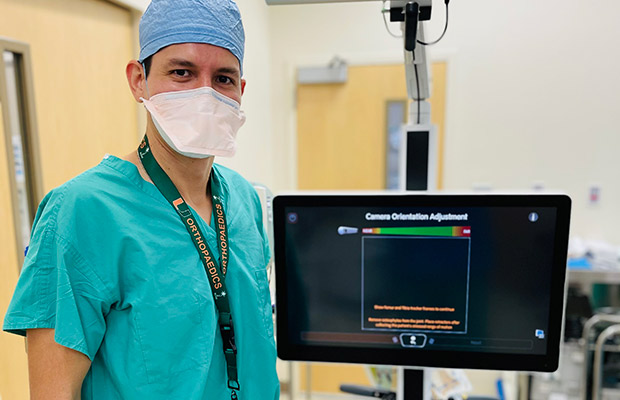
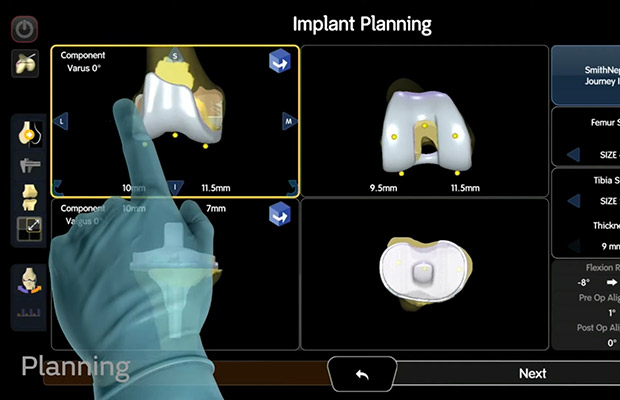
Jackson South Medical Center is equipped with a new, robotic surgical system that aids in making knee replacement surgery more precise and accurate.
The system provides live, 3-D models that help surgeons plan and perform knee replacement procedures with more precision because it allows them to personalize everything – from the size of the implant components, their fit, and the mobility of a new joint.
Jackson South is the only facility in Miami-Dade and Broward counties with a CORI Surgical System for knee replacement procedures. So far, the Jackson team has performed more than 100 knee replacements using this new technology.
We caught up with Jaime Alberto Carvajal Alba, MD, a UHealth – University of Miami Health System orthopedic surgeon who specializes in this type of robotic surgery at Jackson South. Dr. Carvajal explains how this technology works, who can benefit from this type of procedure, and what patients can expect after knee replacement surgery.
Tell us about the new robotic surgical system and how it works for knee replacement surgery.
The CORI Surgical System is a handheld, semi-automated robotic system. It creates a 3D model live during surgery of the patient’s knee anatomy and allows us to assess the person’s range of motion, stability and better understand how their knee behaves. This provides all the information we need to know to restore the person’s own anatomy and assure a knee replacement is placed in an optimal position.
With this particular technology, we see a live 3D model of the patient’s knee during the surgery, so patients do not need to go for CT scans and other imaging before the procedure, as is sometimes required with other systems.
The live, 3D model also helps us set up the surgical plan and adjust it as needed, and then perform the procedure in a very precise manner. It helps me adjust the size of the components, adjust the tension of the ligaments and, at the end of the procedure, ensure the knee is working as it should. The surgery typically takes about one hour.
When someone has knee pain, what is the process for undergoing a knee replacement?
When a patient comes to us with knee pain, we first assess their symptoms and see what conservative measures they’ve tried first. We always recommend conservative management first, such as physical therapy, oral medications, and sometimes injections to see if we can decrease inflammation and pain.
If these measures do not help or aren’t enough to get the patient back to an adequate quality of life, then we offer surgery. Surgery is an option for almost anyone, as long as they don’t have other serious medical conditions that could make the procedure a risk for them.
Who is a candidate for knee surgery using this new handheld robotic system?
This system works for anyone in need of a knee replacement. Using a robotic system increases the accuracy of implant placement, which leads to optimal outcomes.
What’s the recovery processes like after knee replacement surgery?
At Jackson, we’ve been pioneers of a rapid recovery protocol that gets patients back on their feet and back to living their life as soon as possible.
Two hours after the surgery, we help patients out of bed and back on their feet. A physical therapist will come by with a walker to help them begin putting pressure on the leg.
Our patients go home the same day as surgery, which is nice because people enjoy being back in their homes and recovering in their own bed. We send them home with oral medications to control blood clotting and to manage any pain. In most cases, pain usually diminishes within a few days when the inflammation goes down.
Patients have their first physical therapy session the day after surgery. Our goal is to take the walker away about one-and-a-half to two weeks after surgery. Then, they will use a cane for another week or two, as needed.
Most of our patients generally return to their full activity about four weeks after surgery.
Is there anything else a patient should know before considering a knee replacement surgery?
I highly recommend people seek out a team – with a surgeon and surgical support team – that specializes in knee replacement procedures. At Jackson South, we are a high-volume facility performing hundreds of these procedures each year with an entire surgical team dedicated to this type of surgery. This means we have perfected our procedures down to the tiniest details, ensuring the best experience and outcome for our patients.
For more information or to make an appointment at Jackson Health System for robotic knee replacement surgery, call 305-256-4334.
Cutler Bay Man Back on his Feet After Traumatic Brain Injury
Cutler Bay Man Back on his Feet After Traumatic Brain Injury
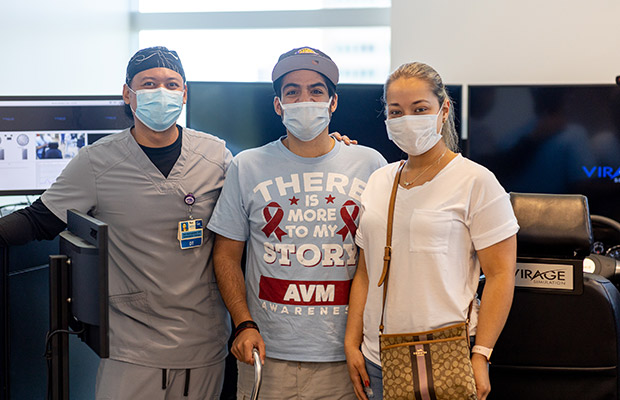

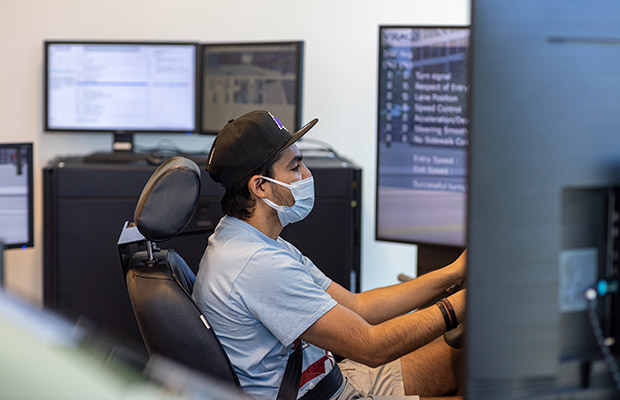
In May 2021, Pedro Grillo and his wife were working out when he started to suffer from a severe headache and extreme exhaustion. Grillo, who was confused at his sudden exhaustion, sat on the floor to regain his energy when he lost consciousness.
Gym staff called 911 as Lyannete Soca-Grillo tended to her husband.
Fire rescue rushed Grillo to the emergency department at Jackson South Medical Center, where he was diagnosed with a ruptured arteriovenous malformation (AVM), an abnormal connection between arteries and veins, which causes severe hemorrhaging in the brain.
Due to COVID-19 protocols restricting visitation, Soca-Grillo was not immediately allowed in the hospital, and by the time they allowed her in, her husband was already intubated. The doctors told her he had fallen into a coma, and his condition was quickly worsening. Grillo was transferred to Jackson Memorial Hospital, where Jacques J Morcos, MD, a UHealth – University of Miami Health System neurosurgeon, was on standby to remove the blood in his skull.
“When the doctors told me they had to transfer Pedro, they warned me that he may not survive the ambulance ride to Jackson Memorial,” Soca-Grillo said. “I was terrified. My husband was alone, unconscious, and didn’t have any idea what he was going through.”
At Jackson Memorial, Dr. Morcos and his staff stabilized Grillo and removed the hemorrhage. A few days later, Dr. Morcos performed a craniotomy – a surgery to open the skull – to remove the AVM. He placed a shunt in Grillo’s brain to drain the excess fluid in his skull.
“AVMs are usually present at birth and are typically only detected after they rupture,” Dr. Morcos said. “Brain AVMs, such as Pedro’s, are rare and affect less than one percent of the population. People living with AVMs can live a long and healthy life without it ever rupturing.”
Grillo spent the next four weeks in a coma at Jackson Memorial recovering.
“All those weeks without Pedro were difficult for me,” Soca-Grillo said. “I couldn’t remember the last good memory we had. I could only picture him in the hospital.”
In July, Grillo’s medical team slowly brought him out of his medically-induced coma. He was unable to speak, eat, or walk, and he suffered from short-term memory loss.
“The last thing I remembered was being in the gym,” Grillo said. “I don’t remember waking up in the hospital, and when I first heard about my injury, I just couldn’t believe it.”
The next phase of his recovery consisted of rehabilitation. Grillo and his wife met with physical and occupational therapists from Christine E. Lynn Rehabilitation Center for The Miami Project to Cure Paralysis at UHealth/Jackson Memorial to discuss his recovery plan.
Over the next month, Grillo underwent intense inpatient occupational and physical therapy sessions four times a week, eight hours a day. After his discharge in August, he continued outpatient therapy at Lynn Rehabilitation Center.
“During our therapy sessions with Pedro, we made it clear to him that we were working to help him regain his independence,” said Gemayaret Alvarez, MD, a UHealth physical medicine physician and medical director of neurorehabilitation at Lynn Rehabilitation Center.
Grillo took his therapy seriously – practicing the skills and exercises he learned daily. He knows that the first year post-surgery is the most critical time frame in his recovery, and he hopes to return to his old self.
“When I saw Pedro after his time at rehab, I couldn’t believe how much better he’s gotten,” Dr. Morcos said. “This was a man who was on the brink of death and is now back on his feet and talking, both of which he couldn’t do when I first operated on him.”
In December 2021, Pedro passed his simulated driving assessment at Lynn Rehabilitation Center and accomplished his goal of being able to drive. He now drives himself to and from his rehab visits. His next big milestone is returning to work at CVS Health.
Today, Grillo is able to walk and climb the stairs of his Cutler Bay home without the aid of a walker or cane. Grillo and his wife are excited to finally be together and resume their lives after missing so much time with each other.
“I’m incredibly blessed to be here today, and when I think back to my injury, it almost doesn’t seem real,” Grillo said. “I’m so thankful to the therapist at Lynn Rehab and the doctors at Jackson Memorial for saving my life.”
New York Man Brought to Jackson Health System for Life-saving Neurosurgery
New York Man Brought to Jackson Health System for Life-saving Neurosurgery
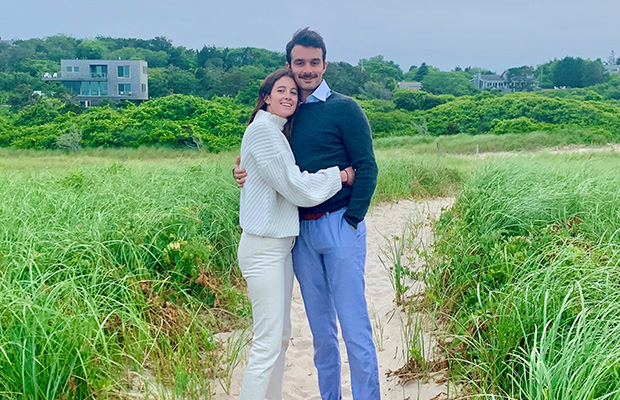
In May 2021, Zac Yezzi found himself in a life-threatening situation after he suffered a stroke.
Yezzi and his fiancé were in St. Barts planning their wedding, when one morning, the 30-year-old began developing a splitting headache that lasted throughout the day. He then lost vision in his right eye, followed by function in his right arm and leg. Somehow, he managed to drag himself to the bathroom and splashed himself with water.
“I was not aware of how traumatic my injury was then, but I knew something was terribly wrong,” Yezzi said. “I asked my fiancé to dial emergency services and request an ambulance.”
Yezzi was rushed to a nearby hospital, where a CT scan revealed that he had a large, eight-centimeter hemorrhage on the left side of his brain, which controls speech. The average hemorrhage is measured in millimeters.
With no neurologist on staff at the hospital in St. Barts, Yezzi was flown to a larger hospital on the nearby island of Guadeloupe. He arrived alone, afraid, and in agonizing pain, unable to communicate with his medical team, who only spoke French.
In Guadeloupe, doctors performed additional tests on Yezzi’s brain, and the results revealed an arteriovenous malformation (AVM) –an abnormal connection between arteries and veins, which would require complex neurosurgery that the hospital was not equipped to perform.
The AVM was determined to be the cause of Yezzi’s initial stroke and hemorrhaging.
While this was happening, Yezzi’s family had contacted the Bee Foundation, an organization that raises awareness about brain aneurysms and hemorrhages. The foundation played a crucial role in getting him transferred by connecting his family with a French-speaking neurosurgeon to communicate with the medical staff in Guadeloupe.
After two days, Yezzi was medically evacuated to Jackson Memorial Hospital. He was accompanied by his fiancé and his father, who were finally able to arrive in Guadeloupe despite multiple flight complications.
“The days leading up to my medevac were two of the longest days of my life,” Yezzi said. “During the flight to Miami, the pressurized cabin was causing me indescribable levels of pain, but I was just relieved to have my fiancé at my side.”
Upon arriving at Jackson Memorial, Yezzi was immediately placed in the neurointensive care unit, where he and his family met with Robert M. Starke, M.D., a University of Miami Health System neurosurgeon and neuroradiologist.
Dr. Starke walked Yezzi and his family through his diagnosis and recommended surgical embolization of the aneurysm and AVM and a craniotomy to remove the aneurysm as the best course of action if they wanted to prevent any recurring brain bleeds.
“Zac should consider himself fortunate,” Dr. Starke said. “Normally, a brain bleed as big as his has the potential to squash the brain, which could lead to death or severe long-term damage.”
After considering his choices, Yezzi elected to undergo surgery.
“I owe everything in my life to Dr. Starke! He and his team saved my life,” Yezzi said. “He’s an incredible surgeon. I’m so lucky to have been transferred to Jackson Memorial.”
Yezzi and his fiancé are back home in New York City, where he’s resumed work. He has made a full recovery, regained his sight, as well as the function in his right arm and leg.
He’s working on promoting awareness and the importance of early detection of brain aneurysms and AVMs to prevent others from having to go through a similar injury.
Naples Twin Celebrating Her Third Transplant Anniversary after Rare Diagnosis of Alagille Syndrome
Naples Twin Celebrating Her Third Transplant Anniversary after Rare Diagnosis of Alagille Syndrome
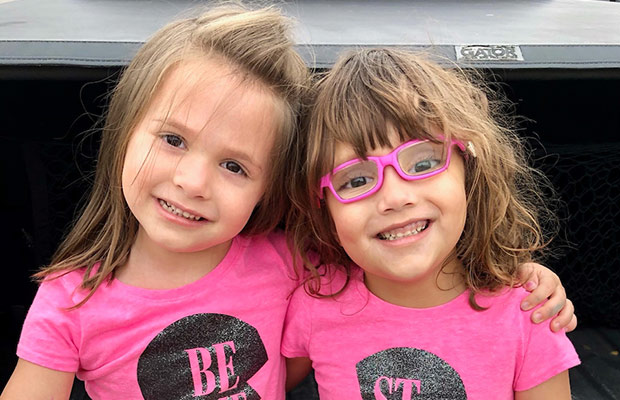
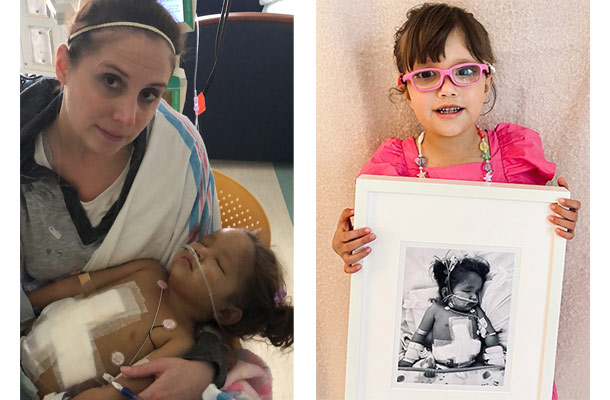
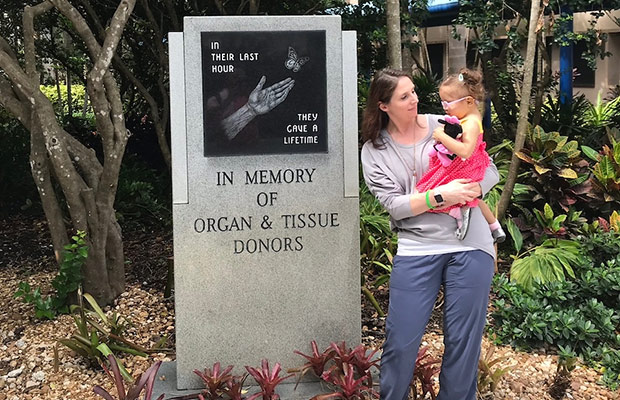
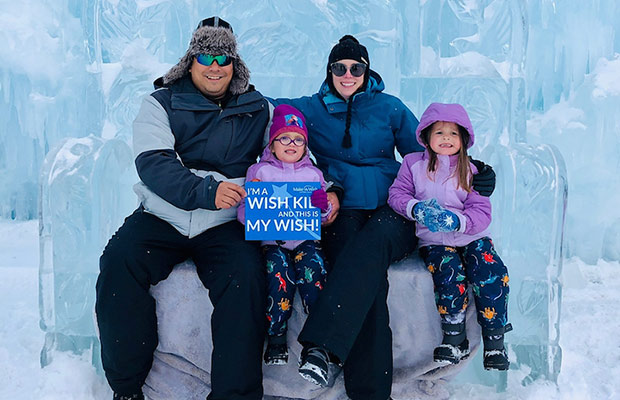
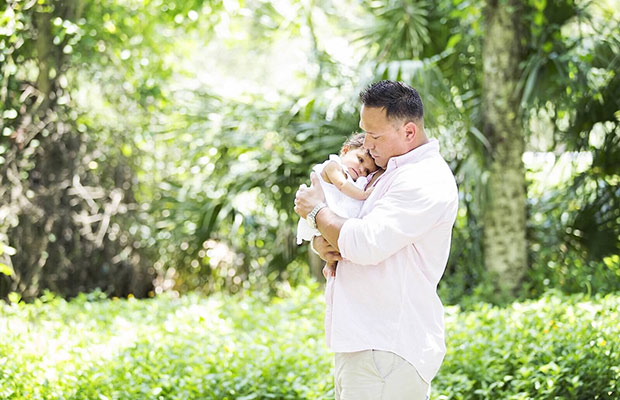
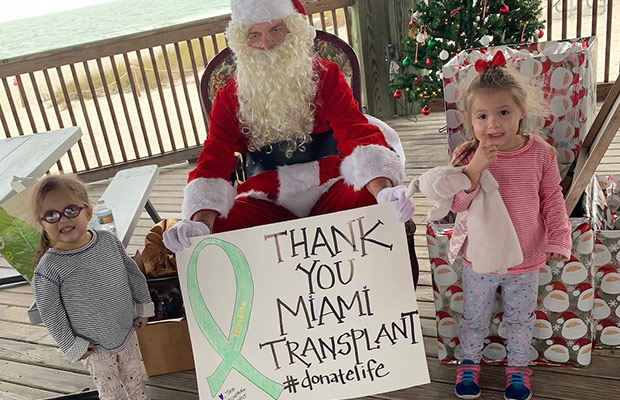
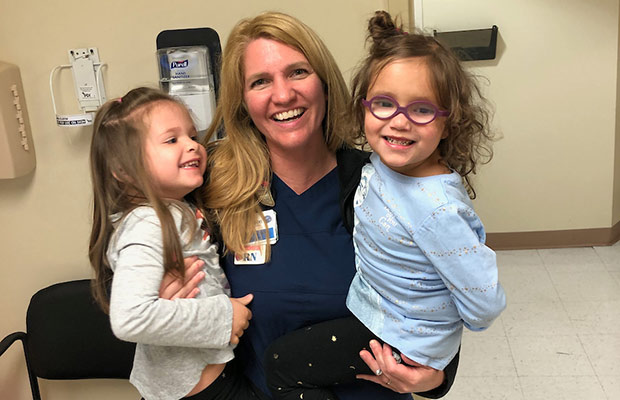

For first-time parents, JoAnna and Kris Palinchak, having twin girls was a dream come true. But three months after delivering healthy twin girls, the new parents noticed that one of their daughters, Ella, was developing differently than her sister, Lacy.
Ella had developed jaundice, a liver condition that causes yellowing of a newborn baby’s skin and eyes. She required immediate medical attention and was taken to a hospital near their home in Naples. Doctors there conducted exploratory surgery and performed a liver biopsy.
Initially, doctors suspected Ella had biliary atresia, a rare and genetic life-threatening disease that affects the bile ducts in the liver of infants. The Palinchaks turned to a trusted gastrointestinal doctor who advised them to have Ella evaluated by the Miami Transplant Institute (MTI), an affiliation between Jackson Health System and UHealth – University of Miami Health System.
Due to their global expertise in complex cases, the medical team at MTI discovered that Ella’s jaundice had manifested into Alagille syndrome, a condition in which bile builds up in the liver because there are too few bile ducts to drain it.
“Alagille syndrome is a rare genetic condition in early childhood in which many organs may be involved, including the liver, heart, brain, kidneys, bones, eyes, and face,” said Tamir Miloh, MD, medical director of MTI’s pediatric transplant hepatology unit. “Ella had developed progressive jaundice, intractable itching, poor sleeping patterns, and stunted growth.”
While normally non-threatening, her condition was causing early-onset liver failure. Though there is currently no cure for the condition, there are ongoing studies at some children’s hospitals on early diagnosis and new innovative medical interventions aimed at improving outcomes and quality of life in these children. Holtz Children’s Hospital at the University of Miami/Jackson Memorial Medical Center is among the hospitals with experience treating children with Ella’s condition.
After meeting with doctors at the Miami Transplant Institute and Holtz Children’s, Ella’s parents were told the best treatment for their daughter would be a liver transplant.
Although the family was scared after receiving the news, they had confidence in Ella’s medical team and quickly bonded with them — especially Kati Garcia, her assigned nurse and transplant coordinator, who had been with the family every step of the way.
“We were afraid, but Kati was very helpful in helping us understand everything that was happening,” Ella’s mom said.
On December 16, 2016 -one day before her first birthday – Ella was listed on the national transplant waiting list.
The Palinkchaks remained hopeful, but the developmental delays of their baby girl began to discourage them. While Lacy began walking at nine months, it took Ella 24 months.
The loving parents would spend the next two years traveling between their home in Naples and Holtz Children’s.
“She was followed by a transplant and heart teams to optimize her nutritional status while we waited for an appropriate donor,” said Dr. Miloh. “Before safely undergoing transplant surgery, she needed intense nutrition support including fat-soluble vitamins and targeted therapy for severe debilitating itching associated with Alagille.”
On March 8, 2018, Ella’s parents were notified that a donor liver was found for their daughter. They quickly packed their bags and drove to Miami.
As the medical team prepared Ella for transplant surgery, the peaceful look on her face gave the worried parents a sense of security that everything was going to be fine. The following morning, Ella underwent a successful liver transplant led by Akin Tekin, MD, UHealth’s liver, intestinal and multivisceral surgeon, and a multidisciplinary pediatric team at Holtz Children’s.
The surgery was a success. And when the Palinchaks got to see their daughter in the pediatric intensive care unit, they were met with an unexpected surprise: Ella’s nurses had brushed and styled her hair.
“We were in the right place, with the right people,” her mother said. “Within two weeks, Ella was discharged, and ever since then, our baby girl started thriving.”
To honor the donor family, a garden with beautiful flowers was planted on the Palinchaks front lawn For Ella and other children who are battling this condition, the Palinchak family hosts an annual fundraiser in their community to raise awareness of Alagille syndrome.
“The family’s selfless act of organ donation during a moment of sadness forever changed our family,” said JoAnna Palinchak. “We have cried sorrowful tears for them and prayed for them. When our daughter is old enough to understand the path of her life, we hope that the ‘person’ at the center of her story can be identified as her lifesaving superhero.”
Now age 5, Ella visits MTI twice a year for check-ups. She’s happy, healthy, and loves spending time with her twin sister.
“Her beautiful scars tell an amazing story that we will never forget,” JoAnna said. “No words are enough to show appreciation and gratitude for all that was done to change Ella’s life. Every single day of her life is better because of the medical team at MTI.”
Sickle Cell Disease + COVID: The Importance of Getting Vaccinated
Sickle Cell Disease + COVID: The Importance of Getting Vaccinated
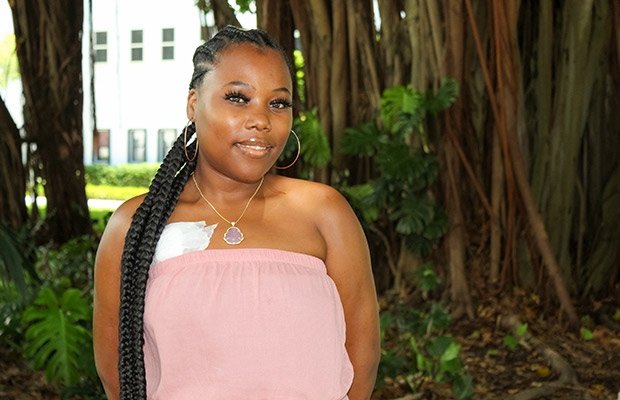

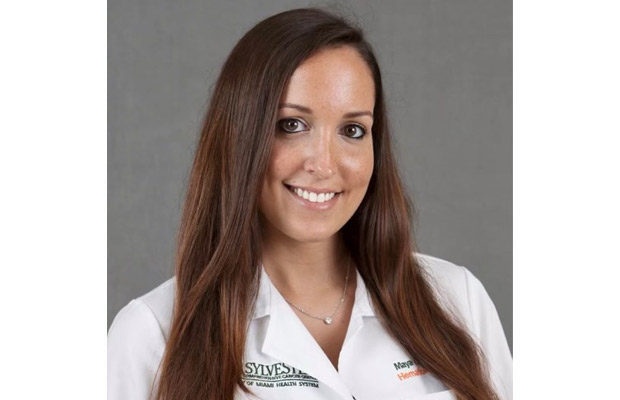
While 28-year-old Keyondra Smart knew at a young age that she suffered from sickle cell disease (SCD), she didn’t fully understand the effects of the illness until four years ago when she was hospitalized at Jackson Memorial Hospital with acute chest syndrome and double pneumonia, which occurs when the infection affects both lungs.
Sickle cell disease is a group of hereditary red blood cell disorders that causes the cells that carry oxygen around the body to become hard, sticky, and c-shaped like a sickle. The cells tend to die early, leading to a shortage of oxygenated blood cells. The disease can also put a patient at a higher risk of developing infections.
The Center for Disease Control estimates that more than 100,000 Americans suffer from SCD, and 1 in 13 Black or African American babies is born with sickle cell trait.
After a month’s stay at Jackson Memorial, Keyondra fell into a deep depression. She had to relearn how to walk and was struggling with the reality of living with the effects of SCD.
“I was on my deathbed and in the intensive care unit for two weeks,” Smart said. “I had never experienced so much pain before. I was mentally, physically, and emotionally exhausted.”
Slowly, Smart came to terms with the disease and began learning about ways to manage her ongoing pain and symptoms.
She returned to school and was determined to graduate despite days when she did not feel well following her treatment.
A few years passed, and as Smart’s life seemed to be getting better, the COVID-19 pandemic hit.
“My anxiety came back because I was so scared of the virus,” she said. “I already have a weak immune system, and this was something I could die from.”
Sickle Cell and COVID
Thomas Harrington, MD, and Maya Bloomberg, MSN, APRN, are the adult sickle cell providers in the Division of Hematology/Oncology at Jackson Memorial. They explained that patients living with sickle cell are at a greater risk of contracting COVID-19. SCD patients who get sick with the virus experience higher rates of hospitalizations and complications, along with worsening sickle cell pain.
Additionally, studies performed before COVID vaccinations were available and the spread of the Delta variant also showed racial disparities in terms of life expectancy due to the virus.
“While life expectancy dropped for all groups, it has been worse for the Black community,” Bloomberg said. “Overall life expectancy dropped by one year for Caucasians and two years for the Black population.”
One study published via PLOS ONE showed that the difference in life expectancy was due in large part to increased exposure at work and access to personal protective equipment.
COVID-19 Vaccine
Faced with the discouraging disparities and risks to patients with sickle cell, Dr. Harrington and Bloomberg are encouraging their patients and the community to get vaccinated.
“You need to put the relative risks in perspective,” Bloomberg said. “The COVID-19 virus is very unpredictable, especially the latest Delta variant. People assume that only older people with health conditions are getting sick and dying, but more and more we’re seeing younger people in the hospital with severe COVID cases.”
If people are worried about the vaccine or have concerns, she encourages them to turn to speak with their doctor.
Keyondra chose to get vaccinated after speaking with Dr. Harrington, who is one of the few experts in sickle cell care in South Florida.
“I know people are scared because there’s a lot of information out there, and they might think it’s a setup, but you should talk to your doctor about any concerns you might have,” Smart said. “I highly recommend other SCD patients get vaccinated, too. We’re already fighting one disease. Who wants to fight two?”
Kendall Woman Back on Her Feet After Year-Long Recovery
Kendall Woman Back on Her Feet After Year-Long Recovery
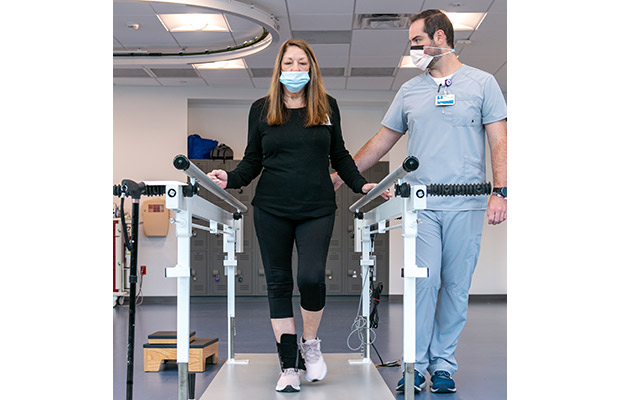
For more than three decades, Cassandra Hirsh has owned Scully’s Tavern, a popular Kendall restaurant.
As Cassandra was getting ready to leave her house and head to work one day last September, the 68-year-old fell down the stairs and suffered a catastrophic injury.
“It happened in the blink of an eye,” she said. “I can’t remember how I fell. I was standing at the top step, and then suddenly, I was on the ground in unimaginable pain.”
Home alone, she laid on the floor, drifting in and out of consciousness, unable to call for help or move to reach for a phone.
It wasn’t until six hours later that her husband, Chris, returned home from the restaurant, where he had been smoking ribs for the week ahead.
He discovered a horrific scene: Cassandra laying on the ground, immobile, in a pool of her own blood. Chris frantically called 911.
Fire rescue carefully lifted Cassandra onto a stretcher. Her nose was broken and her face was covered in bruises. They rushed her to Ryder Trauma Center at Jackson South Medical Center.
A CT scan confirmed that Cassandra had a broken neck and an incomplete spinal cord injury. She was assessed by Ian Cote, MD, a UHealth – University of Miami Health System neurosurgeon who specializes in spine surgery at Ryder Trauma at Jackson South.
“She was in a lot of pain, incredibly weak, and couldn’t move either one of her hands or her right leg,” Dr. Cote said.
To alleviate the pressure of her spinal cord, Dr. Cote performed a complex cervical fusion surgery. This type of traumatic injury is rare, and if her medical team had not acted as expeditiously as they did, Cassandra risked permanent paralysis.
“When Cassandra came to the trauma unit, she had incomplete paralysis in her upper and lower extremities,” Dr. Cote said. “But the surgery went great, and her body responded well to the procedure.”
Following the successful surgery, Cassandra required physical rehabilitation to help her get back on her feet. She chose Christine E. Lynn Rehabilitation Center for The Miami Project to Cure Paralysis at UHealth/Jackson Memorial for its state-of-the-art facility, expert medical team, and commitment to including family in the patient’s rehabilitation and recovery process.
During her six weeks at Lynn Rehabilitation Center, Cassandra underwent intense physical and occupational therapies to relearn how to use the right side of her body. In occupational therapy, her therapists incorporated her love for calligraphy into her daily exercises as a way to work on fine motor skills in her right hand, while her physical therapy focused on helping her regain strength in her right leg.
“Cassandra had a positive attitude and was driven to get better,” said Oliver Acosta, MD, a physical medicine and rehabilitation physician who cared for her. “Our goal at inpatient rehab was to build her back up to help her regain a sense of independence.”
She was discharged just before Christmas and was able to spend the holidays at home with her family.
After completing her outpatient physical and occupational therapy at Lynn Rehabilitation Center, Cassandra was thrilled with how much progress she made. She has regained most of the function in her right hand and is still working on regaining all of the strength in her right leg.
Most importantly, she’s been able to go back to work and continuing managing her restaurant.
“I’m so thankful for the staff at Jackson South and at Lynn Rehab,” Cassandra said. “All of my doctors and nurses were phenomenal throughout my recovery process. I wouldn’t have progressed as quickly as I did if I didn’t have an incredible surgeon and if I wasn’t receiving great care at Lynn Rehab.”
From The Red Carpet To Hospital Hallways: Miami Fashion Designer René Ruiz Designs Miami Transplant Institute Recovery Gowns
From The Red Carpet To Hospital Hallways: Miami Fashion Designer René Ruiz Designs Miami Transplant Institute Recovery Gowns
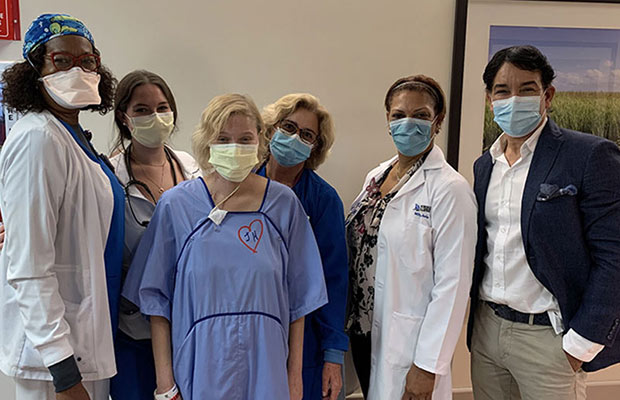
Patients at Jackson Memorial Hospital’s Miami Transplant Institute first in nation to receive custom-made hospital gowns
For more than two decades, Miami fashion designer René Ruiz has designed glamorous gowns that have been worn by celebrities and well-known public figures at red carpet events, galas, and runway shows. Each gown Ruiz makes is designed with the individual in mind with touches inspired by Miami’s rich culture that have been represented in the fashion industry worldwide.
A few years ago, Ruiz began dedicating more time to philanthropy, giving back to the community that has helped grow his brand RENÉ BY RR.
Developing Recovery Gowns for Miami Transplant Institute
That concept was later solidified following an encounter at a local charity event where he met Matthew Pinzur, chief marketing officer at Jackson Health System. The two discussed a collaboration that would allow Ruiz to use his fashion insight to create gowns of a different kind: custom-made hospital gowns for transplant patients recovering from complex surgeries.
Over the course of several months, Ruiz met with representatives from the Miami Transplant Institute (MTI), Jackson leadership, transplant nurses, and post-transplant patients. He learned about their experiences and listened to their recommendations on what it would take to transform a standard hospital gown into a more practical, comfortable gown for this patient population. Among the suggestions was adding snaps and slits in appropriate locations, allowing easier access for the medical teams to check surgical incisions and equipment, such as drains and heart monitors.
Implementation at the Miami Transplant Institute
Ruiz took all of these suggestions to the drawing board and started designing. He researched fabrics that would be comfortable and easily laundered. The result: a denim-blue hospital gown with convenient button snaps and slits. The Miami Transplant Institute team welcomed the change, as did patients of all ages, saying the custom gowns – emblazoned with a JH for Jackson Health inside of Rene Ruiz’s signature red heart icon – are more comfortable and dignified than the standard hospital gown.
“The transplant recovery gown is very utilitarian, it has inside pockets, special button holes for the lines to go in and out,” said Ruiz. “Not only is it going to make the patient’s life while they are recovering easier, but also the nurses and medical staff that work on the transplant patients.”
For this new venture, Ruiz chose Goodwill Industries of South Florida to manufacture the gowns. Staying true to his goal of giving back to the community, he admires Goodwill’s mission of providing hope and job opportunities to people with disabilities and, because he had previously partnered with them for other projects, he knew their work was high quality.
The first gowns were delivered to Jackson Memorial Hospital on June 3, 2021. As a surprise to patients and medical staff alike, Ruiz came in-person to see his design come to life.
Impact and Future for Miami Transplant Institute
“When I witnessed the first patient wearing my design, it was an amazing moment – one of the highlights of my life,” said Ruiz. “It’s been an amazing project for me, this is so fulfilling. What could be better?”
To date, more than 4,000 gowns have been delivered to Jackson Memorial. For now, the gowns are being used exclusively for Miami Transplant Institute’s post-transplant patients.
Renowned fashion designer Rene Ruiz supports Jackson Health System’s mission through philanthropy. To find out how you can also become a supporter on projects like these at Jackson, contact the Jackson Health Foundation today at 305-585-GIVE (4483).


